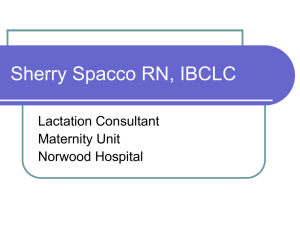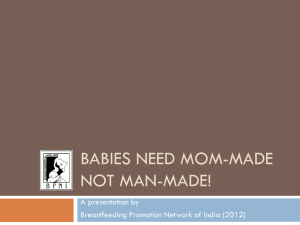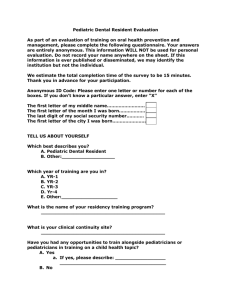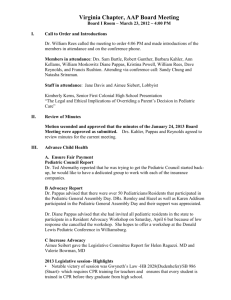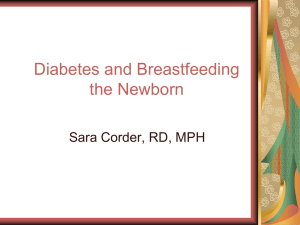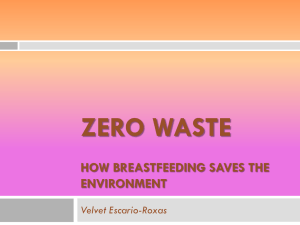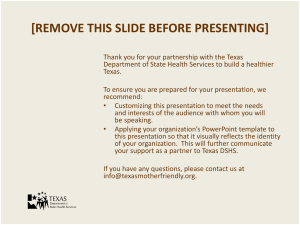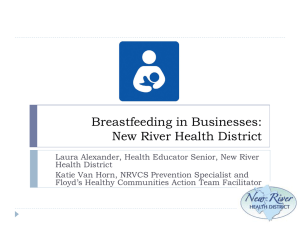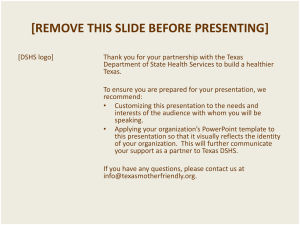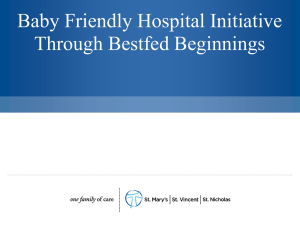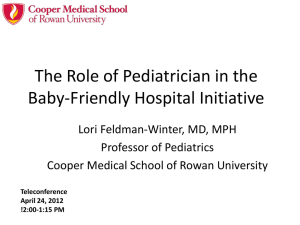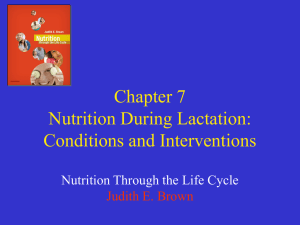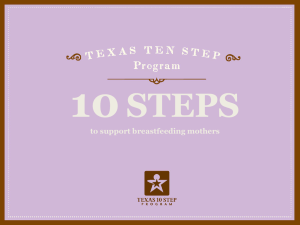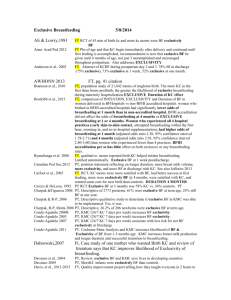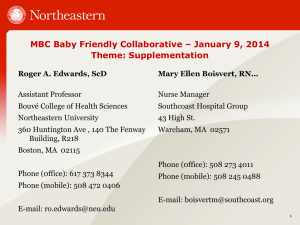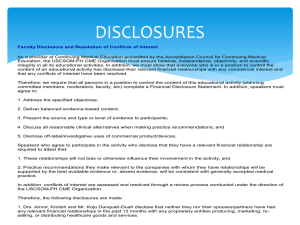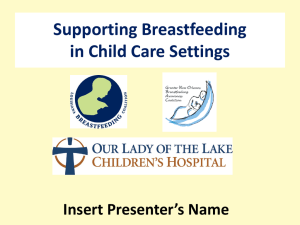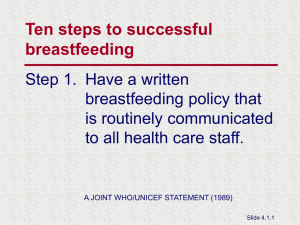Infant Feeding - National Association of Child Care Resource and
advertisement
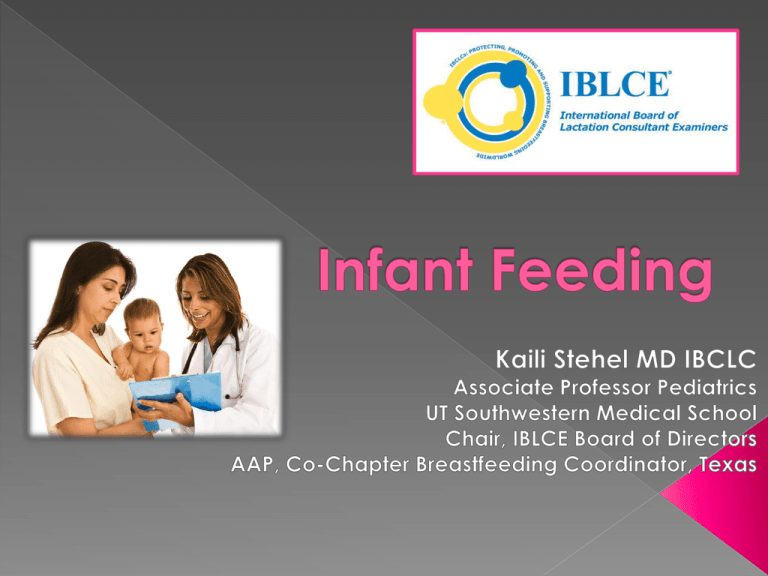
The Report on the WHO Collaborative Study on Breastfeeding, Geneva, 1981. Infant Metabolic Alkalosis and SoyBased Formula -- United States Three cases of a Bartter-like syndrome in infants were reported to CDC from Memphis, Tennessee, on July 26, 1979. The infants were less than 10 months of age and were failing to gain weight. They had poor appetites, and one had a history of constipation. All were hypochloremic and hypokalemic, with varying degrees of alkalosis and microhematuria. The 3 infants were taking the same brand of soy-based formula. Passed in 1980 Established nutrient requirements Established “good manufacturing practices” Since 1982 there have been ~50 formula recalls Last major recall: 9-23-10 Wall Street Journal Headline 1st page Marketplace, “Beetles Spur Recall of Baby Formula” 5 million containers of powdered Similac, expected 100 million in lost sales 3rd quarter 2010 Human milk is species specific, markedly different from all substitute feeding preparations, and uniquely superior for infant feeding “Exclusive breastfeeding is sufficient to support optimal growth and development for approximately the first 6 months of life and provides continuing protection against diarrhea and respiratory tract infection.” “Breastfeeding should be continued for at least the first year of life and beyond for as long as mutually desired by mother and child.” “There is no upper limit to the duration of breastfeeding and no evidence of psychological or developmental harm from breastfeeding into the third year of life or longer.” AAP. BF and the Use of Human Milk. 2005 Raised the targets for BF initiation, duration and exclusivity to increase proportion of infants who are BF Any BF › 82% in hospital › 61% at 6 months › 34% at 1 year Exclusive BF › 44% at 3 months › 23% at 6 months Surgeongeneral.gov Healthypeople.gov % ever BF % BF 6 mo % BF 12 mo % exclusive BF 3 mo % exclusive BF 6 mo State child care center regulation supports lactation US 75 44 24 35 15 TX 75 42 23 31 14 HP 82 2020 HP 75 2010 61 34 44 23 Not optimal N/A 50 25 40 17 N/A Nutritional: Excellent bioavailability, significant nutrient-nutrient interactions not replicable in formula Immunologic: Decreased risk of infections: otitis media, gastroenteritis, bronchiolitis, respiratory tract infections, bacterial meningitis, bacteremia, UTI, and NEC Immunomodulation: Decreased risk for asthma, atopic dermatitis, type 1 and 2 diabetes, leukemia, and lymphoma AHRQ. BF and Mat and Inf Health Outcomes in Developed Countries. 2007 AAP. BF and the Use of Human Milk. 2005 Decreased post partum bleeding and anemia Decreased risk of ovarian cancer and pre menopausal breast cancer More rapid post-partum weight loss Decreased maternal obesity Lactational amenorrhea and improved child spacing AHRQ. BF and Mat and Inf Health Outcomes in Developed Countries. 2007 AAP. BF and the Use of Human Milk. 2005 Early Childhood Obesity Prevention Policies Section 4: Healthy Eating, IOM 2011 › BF results in a reduced risk of pediatric overweight › Duration of BF and exclusive BF inversely related to pediatric overweight › “Promote the consumption of a variety of nutritious foods and encourage and support breastfeeding during infancy” › “child care settings requiring program staff to support breastfeeding” › Rationale: association between breastfeeding and reduction in obesity risk during childhood Does BF reduce the risk of pediatric overweight? CDC 2007 › BF results in a reduced risk of pediatric overweight › Duration of BF and exclusive BF inversely related to pediatric overweight › Persists into adulthood › Conclusive evidence not yet available If 90% of US women BF exclusively for 6 months Prevent 900 deaths/yr Save $13 billion/year in direct and indirect health care costs 10 pediatric diseases: NEC, OM, viral gastro, hospitalization for LRI, atopic dermatitis, SIDS, asthma, leukemia, type 1 DM, obesity Cost of formula not included If 80% BF exclusively 6 months: 741 deaths, $10.5 billion If 50% BF exclusive for 6 months: 142 deaths, $2.2 billion Pediatrics. 2010 Support breast feeding and the use of expressed human milk › AAP, 2005 Provide quality BF Support by accommodating mothers who wish to breastfeed or feed expressed breastmilk › HHS Blueprint for Action on BF, 2000 “Critical role to play” in supporting employed mothers › Action # 16. Surgeon General’s call to Action to Support BF. 2011 encourage, provide arrangements for and support BF “be the mother’s cheerleader and enthusiastic supporter for the mother’s plan to provide her milk” “vigorous efforts…to promote and sustain breastfeeding” Designated place to breastfeed & pump Breastfeedingsymbol.org 1 Designate an individual or group who is responsible for development and implementation of the 10 steps. 2 Establish a supportive breastfeeding policy and require that all staff be aware of and follow the policy. 3 Establish a supportive worksite policy for staff members who are breastfeeding. 4 Train all center staff to carry out breastfeeding promotion and support activities. 5 Create a culturally appropriate breastfeeding friendly environment. 6 Inform expectant parents, new families and visitors about your center’s breastfeeding friendly policies. 7 Stimulate participatory learning experiences with the children related to breastfeeding. 8 Provide a comfortable place for mothers to breastfeed or pump their milk in privacy, if desired. Educate families and staff that a mother may breastfeed her child wherever they have a legal right to be. 9 Establish and maintain connections with your local breastfeeding coalition or other community resources. 10 Maintain an updated resource file of community breastfeeding services and resources kept in an accessible area for families. Wisconsin DHS, 2008 Room Temperature › Freshly Expressed › 3-4 hours at 27-32°C (80-90°F) › 6-8 hours up to 25°C (77°F) Ice pack in cooler › 24 hours at 15°C (59°F) Refrigerated › 4°C (40°F) 5 days Frozen › 2 weeks at -15°C (5°F) freezer inside refrigerator › 3-6 months at -18°C (0°F) separate compartment with doors › 6-12 months at -20°C (-4°F) separate freezer ABM. Human Milk Storage. 2010 Store in shared refrigerator with food Label with infants name and date expressed Defrost in refrigerator or warm water Feed cool, room temperature, or warmed according to infant’s preference Heat to a temperature <98.6°F in warm water <120°F, not in microwave, heat less than 5 minutes Previously frozen, thawed 24 hours › Room temperature, discard after a few hours › After partially drunk, discard within 1-2 hours Human milk does not require special handling › No gloves ABM. Human Milk Storage. 2010 and CFOC 3rd edition Exclusive BF minimum 4 mo preferable 6 mo No nutritional indication to add complementary foods before 4-6 months Introduce one single ingredient food at a time, at intervals of 3-5 days to observe for allergies No evidence to support particular order By 6 months introduce iron rich complementary foods (fortified rice cereal, meat added benefit of zinc, protein) Try to offer variety, 8-15 exposures may be needed before new food accepted AAP. Pediatric Nutrition Handbook. 6th edition. 2009. Never doubt that a small group of thoughtful, committed citizens can change the world. Indeed, it is the only thing that ever has. -Margaret Mead AAP. BF and the Use of Human Milk. Pediatrics. 2005 AAP. Pediatric Nutrition Handbook. 2009. ABM. Clinical Protocol: Human Milk Storage for Home Use for Full-Term Infants. BF Medicine. 2010 AHRQ. BF and Mat and Inf Health Outcomes in Developed Countries. 2007 Caring for our Children 3rd Edition. 2011 CDC BF Report Card. 2011 HHS Blueprint for Action on BF. 2000 IOM. Early Childhood Obesity Prevention Policies. 2011 The Surgeon General’s Call to Action to Support BF. 2011
